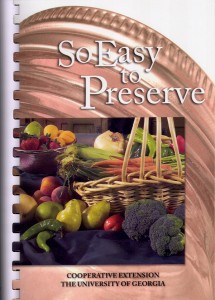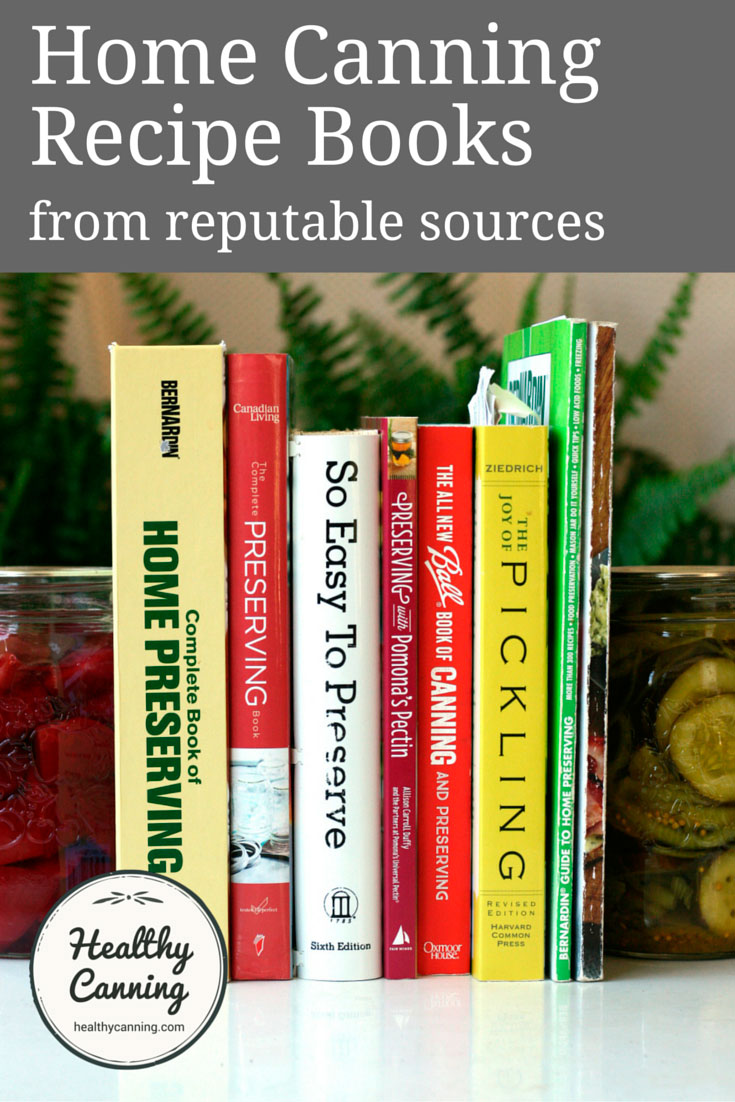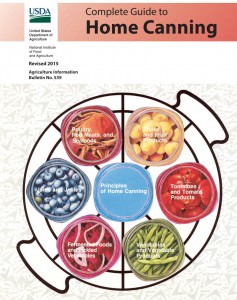Healthy Canning is often asked to recommend recipe books. These are the ones that we are currently able to put forward for consideration as providing tested, safe recipes from reputable sources.
We do recommend that you always work from the most recent edition of a canning book. The purpose is not to get you to part with your hard-earned money: rather, it’s to ensure that you always have the latest in safe home canning information to work with. The world of home canning has been evolving very quickly in the past 10 or 20 years, thanks to the leadership provided by the National Center for Home Food Preservation.
There are also many reliable online recipe sources for home canning as well.
See also the discussion on defining “reputable sources for home canning information.”
All together, these printed books hold a collection of around 2,000 tested home canning recipes from reputable sources (there may be some duplication — e.g. applesauce, canning plain carrots, etc. — between books.)
Recipe counts provided below are for recipes for actual canning only; numbers exclude recipes for refrigerated or frozen storage, or sample recipes on how to use the preserves.
The book with the most recipes by far is the Ball / Bernardin Complete, with a whopping 380ish recipes for home canning. It is written in Canada for publication by both Bernardin and Ball.
What is the cut off date for canning books?
Some authorities say not to use canning books published before 2009, because in 2009, the USDA’s home canning division released some important research findings, and everyone else in the US and Canada then updated their own publications to take those into account. Others put the date at 1994.
Other respected authorities say that to be intellectually honest, it’s hard to fix an abitrary cut-off date, as there are many books from this current year even that they would not recommend. And, that going by a cut-off date is not a reliable way to decide if recommendations are good ones or not.
Still, it can be hard for canning book authors and editors to track which changes were made in which editions, so that is why they must always say that the most current edition of their book is the one they will support. Sometimes minor typos are corrected. Perhaps a recipe should have called for 1 ½ tablespoons of salt, and 1 ½ teaspoons was printed instead.
So, rather than looking at a hard and fast cut-off date, it’s best to try to determine what are the reliable, trusted sources by the vast majority of safe, careful, informed, up-to-date home canners and professionals in the field, and then what are the most recent publications from those sources.
What can Master Food Preservers recommend?
Master Food Preservers (MFP) are allowed to recommend the National Center / USDA, or Ball, as well as recipes from their own university extension. And that’s it. They can’t even recommend Bernardin, though they recommend the Ball Complete, which Bernardin writes.
Privately, most of them will use a much broader range of books. It’s not so much that the MFP program is trying to do thought control: it’s just that, with such a broad program spread out across the country, they’re just trying to make sure they have everyone singing from the same hymn book as much as possible on at least one topic.
Don’t narrow your range of choices unnecessarily
There’s a trend for many well-meaning, beginner canners to advise others to use only recipes from the National Center / USDA, or Ball. While certainly safe advice, it’s very restrictive, and as canners mature in the field, they will cautiously broaden their list of sources. And caution is good in this field!
Ball itself is not perfect — its latest All New has drawn much controversy, and the 37th edition of the Blue Ball had some recipe errors in it. And the National Center itself recommends another recipe source: So Easy to Preserve.
The authors of So Easy to Preserve, Elizabeth Andress and Judy Harrison, have this advice about home canning recipe books:
The best sources of instructions for home canning are the recently published booklets prepared by the Cooperative Extension Service at many land-grant universities, the US Department of Agriculture (USDA), major manufacturers of home canning equipment or other reliable professionals.
Avoid following the home canning advice of untrained celebrities, old cookbooks, “back to nature” publications, and out-of-date home canning leaflets. Some potentially dangerous instructions can be found in old official publications, even those from this state! [Ed: Georgia] Be sure you have the latest publications based on current research!” [1] Andress, Elizabeth L. and Judy A. Harrison. So Easy to Preserve. University of Georgia Cooperative Extension. Bulletin 989. Sixth Edition. 2014. Page 25.
Note the mention of Dr Elizabeth Andress above. She is head of the National Center, co-author of So Easy to Preserve, and in charge of the USDA Complete Guide. Her position does not allow her to specifically endorse anyone in the private sector outright, but she says, “major manufacturers of home canning equipment or other reliable professionals.”
The question then becomes, which major manufacturers, and which professionals, are reliable?
That’s a question that people can debate for hours, but our proposed answer is: anyone who meets or exceeds USDA standards for home canning procedures, quality and safety margins. We like to see that the recipes have been lab tested for pH, density, etc. for full sterilization of all possible foodborne pathogens, and / or reviewed by actual qualified and certified professionals in the field for safety.
USDA Complete Guide to Home Canning
Most recent edition: 2015.
The USDA Complete Guide to Home Canning (2015) has approximately 145 recipes for canning.
It is offered online for free. You can also order it in printed book form.
The recipes are for both water bath (or steam) canning and for pressure canning.
USDA Complete Canning Guide 2015 (separate chapter PDF’s)
USDA Complete Canning Guide 2015. Merged PDF. HealthyCanning merged the above separate PDFs into one PDF for your convenience. You have our word that we made no alterations at all in the merge. You can read this on an iPad with a PDF reader or on home computer or print it out.
See our USDA Complete Guide page for a complete discussion of the USDA Complete, including history and possible errata.
University of Georgia
Most recent edition: 2014.

So Easy To Preserve
So Easy to Preserve has approximately 275 recipes in it for home canning.
The recipes are for both water bath (or steam) canning and for pressure canning.
Here is a review of So Easy to Preserve.
Here is where you order So Easy to Preserve.
You can also consider the book a reliable authority on freezing.
Pomona Pectin
Most recent edition: 2013.
Preserving with Pomona’s Pectin has approximately 75 recipes for home canning.
The book contains sugar-free or reduced recipes using Pomona’s Pectin.
The recipes are for both water bath (or steam) canning.
Ball
Most recent editions: 2014 (Ball Blue Book); 2015 (Complete); 2016 (All New); 2017 (Back to Basics.)
See also: review and the history of the Ball Blue Book; a comparison of all of Ball’s canning books.
The Ball Blue Book (37th edition) contains approximately 225 recipes for home canning; the Ball Complete contains approximately 380 recipes for home canning; the All New has approximately 125 gourmet-level recipes for home canning. [Ed: Note that as of 2016 some Extensions are expressing reservations about some recipes in the Ball All New book, and are unhappy with the response from Ball to their concerns.]
All have recipes for both water bath (or steam) canning and for pressure canning.
Ball Blue Book, UK edition (proper real metric, i.e. measurements in weight instead of volume)
Ball Blue Book in South Africa (Ball South Africa site closed sometime towards end of 2017)
Bernardin
Most recent edition: 2013 (Guide); 2015 (Complete).
See also: reviews of Bernardin’s home canning books.
Bernardin, an American company founded in Evansville, Indiana, is the sister company to Ball; both are owned by Newell (formerly Jarden.) Newell now restricts Ball’s market activity primarily to the south of the Canadian border, and Bernardin’s activities to the north of the border. It’s never too long though before the observant eye notices the full range of shared products, recipes and intellectual capital between the two companies, with different logos slapped on for their sales territories (the same is true of Kerr, though Newell has ceased Kerr’s recipe activities.)
The Bernardin Guide (2013) contains approximately 215 recipes for home canning. When purchasing the Guide, as of summer 2017, make sure you are getting the 2013 edition, with a greenish cover.
The Bernardin Complete (marketed in the States named as the “Ball Complete”) contains approximately 380 recipes for home canning. Bernardin offre aussi ce livre de conserves en français.
Both Bernardin books have recipes for both water bath (or steam) canning and for pressure canning.
Bernardin meets / or exceeds USDA standards (for instance, they have long advised lemon juice to acidify applesauce, as Ball is just now starting to do as well.)
Canadian Living
Most recent edition: 2012.
Canadian Living’s ‘Complete Preserving Book’ contains approximately 150 gourmet-level recipes for water-bath or steam canning.
All Canadian Living recipes for home canning are tested to meet or exceed USDA standards in test labs for safety.
See also: review of the Canadian Living Home Canning book.
Linda Ziedrich
Most recent edition: 2016 (Joy of Pickling); 2009 (Joy of Jams)
Ziedrich’s Joy of Pickling has approximately 225 recipes for water bath (or steam) canning.
Her ‘Joy of Jams, Jellies, & Other Sweet Preserves’ contains approximately 150 recipes for water bath (or steam) canning.
You will, however, find very few if any low-sugar or low-salt recipes in her works. Most of her jams and jellies, for instance, are pectin-free and absolutely rely on refined white sugar to make the gel work.
Note: The third edition of the Joy of Pickling came out in August 2016.
Ellie Topp
Most recent edition: 2007 (The Complete Book of Small-Batch Preserving)
The first book on small batch home canning was probably published in 2001, “The Complete Book of Small-Batch Preserving.”
Written by Ellie Topp, it’s considered a safe canning book by many informed, experienced canners, as Topp has a Masters degree in food science (University of Wisconsin), where she did a major in experimental foods with a minor in microbiology on organisms causing foodborne illness. She was then a research associate in the Department of Food Research at the University of Illinois.
Several of the recipes were developed in collaboration with labs at Health Canada and then later published as an academic paper in the peer-reviewed journal, Food Research International (Topp, E.B., F.J. Cook, G.C. Topp. “Heating oils with fresh vegetable inclusions: modelling and measurement of heating pattern.” Vol.36 [2003] 831-842).
Like Judi Kingry, author of the Ball / Bernardin Complete Book, Topp now makes her home on the Canadian side of the border, where she is on two national committees: the Canada Agriculture Museum Food Science National Advisory Committee, and the Canadian Partnership for Consumer Food Safety Education Committee.
References













Eilish
Hi all, I’m new to pressure canning! I was wondering if there are any tried and true, safe Butter Chicken pressure canning recipes online that are proven safe and delicious?!
Healthy Canning
Hi Eilish, many safe canning groups endorse the standard Butter Chicken recipe for pressure canning that makes the rounds. If you go by Ball’s guidelines, which are process for the longest time ingredient, then it would seem to be fine, as it’s basically chicken pieces in a chunky seasoned tomato sauce. USDA does not, however, back that rule, and goes instead by composition, density and heat-penetration of ingredients for each unique combination. It’s for that reason that we haven’t listed that Butter Chicken recipe on our site. You could ask Ball via their FB page and see what they say.